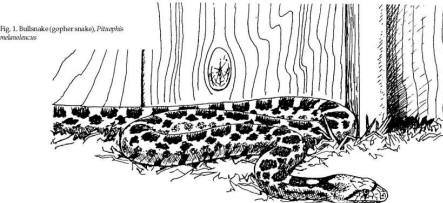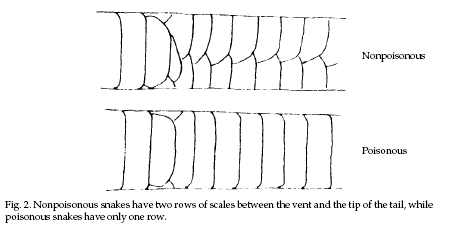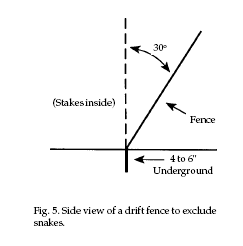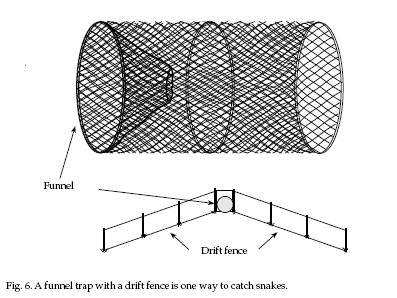|
|
|
|
 |
REPTILES, AMPHIBIANS, ETC: Nonpoisonous
Snakes |
|
|

Identification
Of the many kinds of
snakes found in the United States, only the following
are harmful: rattlesnakes, copperheads, cottonmouths,
coral snakes, and sea snakes. The latter group lives
only in the oceans. All poisonous snakes, except coral
snakes and sea snakes, belong in a group called pit
vipers. There are three ways to distinguish between pit
vipers and nonpoisonous snakes in the United States:
(1) Allpit vipers have a
deep pit on each side of the head, midway between the
eye and the nostril. Nonpoisonous snakes do not have
these pits.
(2) On the underside of
the tail of pit vipers, scales go all the way across in
one row (except on the very tip of the tail, which may
have two rows in some cases). On the underside of the
tail of all nonpoisonous snakes, scales are in two rows
all the way from the vent of the snake to the tip of the
tail (Fig. 2). The shed skin of a snake shows the same
characteristics.
(3) The pupil of pit
vipers is vertically elliptical (egg-shaped). In very
bright light, the pupil may be almost a vertical line,
due to extreme contraction to shut out light. The pupil
of nonpoisonous snakes is perfectly round (Fig. 3).
The poisonous coral snake
is ringed with red, yellow, and black, with red and
yellow rings touching. Nonpoisonous mimics of the coral
snake (such as the scarlet king snake) have red and
yellow rings, separated by black rings. A helpful saying
to memorize is: “Red on yellow, kill a fellow; red on
black, friend of Jack.”
Range
Some species of
nonpoisonous snakes occur throughout several states, but
the majority have only limited ranges.


Fig. 3. Nonpoisonous
snakes have a round eye pupil and have no pit between
the eye and the nostril.
Habitat
Snakes are not very
mobile, and even though some are fairly adaptable, most
have specific habitat requirements. Some live
underground (these are mostly small in size), and some
have eyes shielded by scales of the head. Others, such
as green snakes, live primarily in trees. One group
spends its entire life in the oceans. In general, snakes
like cool, damp, dark areas where they can find food.
The following are areas around the home that seem to be
attractive to snakes: firewood stacked directly on the
ground; old lumber piles; junk piles; flower beds with
heavy mulch; gardens; unkempt basements; shrubbery
growing against foundations; barn lofts— especially
where stored feed attracts rodents; attics in houses
where there is a rodent or bat problem; stream banks;
pond banks where there are boards, innertubes, tires,
planks, and other items lying on the bank; unmowed
lawns; and abandoned lots and fields.
Food Habits
All snakes are predators,
and the different species eat many different kinds of
food. Rat snakes eat primarily rodents (such as rats,
mice, and chipmunks), bird eggs, and baby birds. King
snakes eat other snakes, as well as rodents, young
birds, and bird eggs. Some snakes, such as green snakes,
eat primarily insects. Some small snakes, such as earth
snakes and worm snakes, eat earthworms, slugs, and
salamanders. Water snakes eat primarily frogs, fish, and
tadpoles.
General Biology, Reproduction, and Behavior
Snakes are specialized
animals, having elongated bodies and no legs. They have
no ears, externally or internally, and no eyelids,
except for a protective window beneath which the eye
moves. The organs of the body are elongated. Snakes have
a long, forked tongue, which helps them smell. Gaseous
particles from odors are picked up by the tongue and
inserted into the two-holed organ, called the Jacobson’s
Organ, at the roof of the mouth.
The two halves of the
lower jaw are not fused, but are connected by a ligament
to each other. They are also loosely connected so the
snake can swallow food much larger than its head.
Because snakes are cold-blooded and not very active, one
meal may last them several weeks. Also, because they are
cold-blooded, they may hibernate during cold weather
months or aestivate during hot summer months when the
climate is severe. In either case, they consume little
or no food during these times. Some snakes lay eggs,
some hatch their eggs inside the body, and some give
live birth. The young of copperheads, rattlesnakes, and
cottonmouths are born alive.
Nonpoisonous snakes are
harmless to humans. In most cases, a snake will crawl
away when approached if it feels it can reach cover
safely. No snakes charge or attack people, with the
exception of the racers, which occasionally bluff by
advancing toward an intruder. Racers will retreat
rapidly, however, if challenged. Snakes react only when
cornered. Different species react in different ways,
playing dead by turning over on the back, hissing,
opening the mouth in a menacing manner, coiling, and
striking and biting if necessary.
Damage and Damage Identification
A nonpoisonous snake bite
has no venom and can do no more harm than frighten the
victim. After being bitten several thousand times by
nonpoisonous snakes, the author and his students have
never suffered any adverse reaction, and no treatment
was ever used. The only harm nonpoisonous snakes can
cause is frightening people who are not familiar with
them. A bite from a poisonous snake, however, causes an
almost immediate reaction—swelling, tissue turning a
dark blue-black, a tingling sensation, and nausea. If
none of these is observed or felt, the bite was from a
nonpoisonous snake. Also, bites from one of the pit
vipers (copperheads, rattlesnakes, and cottonmouths)
will reveal two fang marks, in addition to teeth marks.
All snakes have teeth; only pit vipers have fangs. North
American pit vipers have only two rows of teeth on top
and two on the bottom, whereas nonpoisonous snakes have
four on top and four on the bottom.
Legal Status
In most states, snakes are
considered nongame wildlife and are protected by state
law unless they are about to cause personal or property
damage. Therefore, snakes should not be indiscriminately
killed. Some species are listed on federal and/or state
threatened and endangered species lists.
Damage
Prevention and Control Methods
Exclusion
Snakes enter houses, barns
and other buildings when habitat conditions are suitable
inside the buildings. They are particularly attracted to
rodents and insects as well as cool, damp, dark areas
often associated with buildings. All openings 1/4 inch
(0.6 cm) and larger should be sealed to exclude snakes.
Check the corners of doors and windows, as well as
around water pipe and electrical service entrances.
Holes in masonry foundations (poured concrete and
concrete blocks or bricks) should be sealed with mortar
to exclude snakes. Holes in wooden buildings can be
sealed with fine mesh (1/8-inch [0.3-cm]) hardware cloth
or sheet metal.
In some cases, the
homeowner may get peace of mind by constructing a
snake-proof fence around the home or yard (Fig. 4). A
properly constructed snake-proof fence will keep out all
poisonous snakes and most harmless snakes (some
nonpoisonous snakes are fairly good climbers). The cost
of fencing a whole yard may be high, but it costs little
to enclose a play space for children too young to
recognize dangerous snakes. The following design is
taken from information from the US Fish and Wildlife
Service.
The fence should be made
of heavy galvanized hardware cloth, 36 inches (91 cm)
wide with a 1/4-inch (0.6-cm) mesh. The lower edge
should be buried 6 inches (15 cm) in the ground, and the
fence should be slanted outward from the bottom to the
top at a 30o angle (Fig. 5). Place supporting stakes
inside the fence and make sure that any gate is tightly
fitted. Gates should swing inward because of the outward
slope of the fence. A 36-inch (91-cm) vertical fence
with a 12-inch (30-cm) lip at the top, facing outside
and angled downward at a 30o angle would probably work
as well.


Any opening under the
fence should be firmly filled—concrete is preferable.
Mow all vegetation just outside the fence, for snakes
might use these plants to help climb over the fence. If
children tend to crush the fence, it must be supported
by more and sturdier stakes and by strong wire connected
to its upper edge.
Habitat Modification
The primary food of most
snakes, especially the larger ones, is birds, bird eggs,
and rodents such as rats, mice, and chipmunks. No
control program for rodent-eating snakes is ever
complete without removing rodents and rodent habitats.
Put all possible sources of rodent food in secure
containers. Be sure to keep all dog or cat food cleaned
up after each feeding and make the stored food
unavailable to the rodents. Keep all vegetation closely
mowed around buildings. Remove bushes, shrubs, rocks,
boards, and debris of any kind lying close to the
ground, as these provide cover for both rodents and
snakes. Refer to the chapters on rodents for more
information on their control.
Frightening
Not applicable.
Repellents
Several repellents have
been used in the past, but none has been consistently
effective. Currently Dr. T’sTM Snake-A-Way® is
registered for the control of rattlesnakes and the
checkered garter snake, but is apparently not effective
against most species of snakes. Active ingredients
include sulfur and naphthalene. Band applications around
the area to be protected are recommended.
Fumigants
There are no legal
fumigants to kill snakes. Moreover, because most snakes
do not burrow, using fumigants in underground burrows is
not a feasible method of control. In the past, pest
control operators have completely encased houses with
plastic and fumigated at tremendous expense to the
homeowner (several thousand dollars). This is not a
reasonable control method for nonpoisonous snakes since
the animals being killed are completely harmless.
 Trapping Trapping
One method reported by
researchers to catch snakes involves a funnel trap with
drift fences constructed of 1/4- inch or 1/2-inch (0.6-
or 1.3-cm) mesh hardware cloth erected 2 feet (0.6 m)
high and 25 feet (7.5 m) long. Posts for drift fences
should be on the back side of the fence. These fences
guide animals into the funnel end of the trap (Fig. 6).
One type of funnel trap
can be made by rolling a 3 x 4-foot (0.9 x 1.2-m) piece
of 1/4-inch (0.6-cm) mesh hardware cloth into a cylinder
about 1 foot (0.3 m) in diameter and 4 feet (1.2 m)
long. An entrance funnel can be made similarly a
cylinder with hardware cloth and attach the drift fence.
To catch the animal from either direction, put another
funnel at the other end of the trap and another drift
fence facing the opposite direction.
Shooting
Nonpoisonous snakes are
protected by law in most states, and indiscriminate
killing is illegal. Shooting or clubbing is extremely
effective in states where it is allowed and will soon
eliminate the snake population. Permission may be
required from the local state wildlife agency.
Other Methods
It is not difficult to
remove snakes from inside a house or other buildings.
Place piles of damp burlap bags or towels in areas where
snakes have been seen or are likely to be found. Cover
each pile with a dry burlap bag or towel to slow
evaporation. Snakes are attracted to damp, cool, dark
areas such as these piles. After the bags or towels have
been out for a couple of weeks, completely remove them
with a large scoop shovel during the middle of the day
when snakes are likely to be inside or underneath.
Glue boards have proven to
be useful for trapping snakes in or under buildings.
Securely tack several rodent glue traps (or use bulk
glue) to a plywood board approximately 24 x 16 inches
(61 x 41 cm) to make a glue patch at least 7 x 12 inches
(15 to 30 cm). Place the board against a wall where
snakes are likely to travel. Snakes become stuck when
they try to cross the board. Do not place the board near
any object (pipes or beams) that the snake can use for
leverage in attempting to free itself. A hole drilled
through the plywood board will allow removal of the
board and the entrapped snake with a long stick or
hooked pole. Animals trapped in the glue can be removed
with the aid of vegetable oil, which counteracts the
adhesive.
Do not use glue boards
outdoors or in any location where they are likely to
catch pets or nontarget wildlife. The glue can be quite
messy and is hard to remove from animals.
Economics of Damage and Control
As mentioned earlier,
nonpoisonous snakes are completely harmless and cause no
damage, except occasionally frightening people.
Therefore, no expense toward control of nonpoisonous
snakes is justified. Most methods to remove snakes are
inexpensive, except for the snake-proof fence, which can
be quite expensive.
Acknowledgments
Appreciation is expressed
to the US Fish and Wildlife Service for some of the
information presented in this chapter, particularly the
design of the snake-proof fence.
Figures 1 through 3 by
Emily Oseas Routman.
Figures 4 through 6 by
Jill Sack Johnson.
For Additional Information
Boys, F. E. 1959.
Poisonous amphibians and reptiles. C. C. Thomas Co.,
Springfield, Illinois. 149 pp.
Conant,
R. 1975. A field guide to reptiles and amphibians of
eastern and central North America. Houghton Mifflin Co.,
Boston. 429 pp.
Ditmars,
R. L. 1939. A field book of North American snakes.
Doubleday, Doran, and Co., New York. 305 pp.
Ditmars,
R. L. 1966. Snakes of the world. Macmillan Co., New
York, 207 pp.
Huheey, J. E., and A.
Stupka. 1967. Amphibians and reptiles of the Great
Smokey Mountains National Park. Univ. Tennessee Press,
Knoxville. 98 pp.
Lamburn,
J. B. C. 1964. Snake lore. Doubleday and Co., New York.
152 pp.
Leviton,
A. E. 1971. Reptiles and amphibians of North America.
Doubleday and Co., New York. 250 pp.
Parker, H. W. 1977. Snakes
— a natural history. Cornell Univ. Press, 124 pp.
Schlauch,
F. C. 1976. City snakes, suburban salamanders. Nat. Hist.
85:46-53.
Schmidt, K. P., and D. D.
David. 1941. Field book of snakes of the United States
and Canada. G. P. Putnam’s Sons. New York. 365 pp.
Simon, H. 1973. Snakes:
the facts and the folklore. Viking Press, New York. 128
pp.
Stidworthy,
J. 1972. Snakes of the world. Bantam Books, Inc., 159
pp.
Editors
Scott E. Hygnstrom Robert
M. Timm Gary E. Larson
PREVENTION AND CONTROL OF
WILDLIFE DAMAGE — 1994
Cooperative Extension
Division Institute of Agriculture and Natural Resources
University of Nebraska -Lincoln
United States Department
of Agriculture Animal and Plant Health Inspection
Service Animal Damage Control
Great Plains Agricultural
Council Wildlife Committee
01/26/2007
Special
thanks to:
Clemson University
|